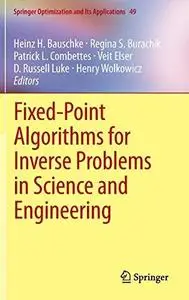Fixed-Point Algorithms for Inverse Problems in Science and Engineering By Heinz H. Bauschke, Mason S. Macklem (auth.), Heinz H. Bauschke, Regina S. Burachik, Patrick L. Combettes, Veit Elser, D. Russell Luke, Henry Wolkowicz (eds.)
2011 | 404 Pages | ISBN: 1441995684 | PDF | 4 MB
2011 | 404 Pages | ISBN: 1441995684 | PDF | 4 MB
Fixed-Point Algorithms for Inverse Problems in Science and Engineering presents some of the most recent work from leading researchers in variational and numerical analysis. The contributions in this collection provide state-of-the-art theory and practice in first-order fixed-point algorithms, identify emerging problems driven by applications, and discuss new approaches for solving these problems.This book is a compendium of topics explored at the Banff International Research Station “Interdisciplinary Workshop on Fixed-Point Algorithms for Inverse Problems in Science and Engineering” in November of 2009. The workshop included a broad range of research including variational analysis, numerical linear algebra, biotechnology, materials science, computational solid-state physics, and chemistry.Key topics and features of this book include:· Theory of Fixed-point algorithms: variational analysis, convex analysis, convex and nonconvex optimization, subdifferential calculus, nonsmooth analysis, proximal point methods, projection methods, resolvent and related fixed-point theoretic methods, and monotone operator theory· Numerical analysis of fixed-point algorithms: choice of step lengths, of weights, of blocks for block-iterative and parallel methods, and of relaxation parameters; regularization of ill-posed problems; numerical comparison of various methods· Applications: Image and signal processing, antenna optimization, location problemsThe wide scope of applications presented in this volume easily serve as a basis for new and innovative research and collaboration.



